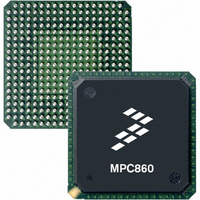MPC855TCVR50D4 Freescale Semiconductor, MPC855TCVR50D4 Datasheet - Page 82

MPC855TCVR50D4
Manufacturer Part Number
MPC855TCVR50D4
Description
IC MPU POWERQUICC 50MHZ 357PBGA
Manufacturer
Freescale Semiconductor
Datasheets
1.MPC855TVR50D4.pdf
(15 pages)
2.MPC8555ECVTALF.pdf
(88 pages)
3.MPC855TCVR50D4.pdf
(80 pages)
Specifications of MPC855TCVR50D4
Processor Type
MPC8xx PowerQUICC 32-Bit
Speed
50MHz
Voltage
3.3V
Mounting Type
Surface Mount
Package / Case
357-PBGA
Processor Series
MPC8xx
Core
MPC8xx
Data Bus Width
32 bit
Maximum Clock Frequency
50 MHz
Operating Supply Voltage
2.5 V, 3.3 V
Maximum Operating Temperature
+ 95 C
Mounting Style
SMD/SMT
Minimum Operating Temperature
- 40 C
Family Name
MPC8xx
Device Core
PowerQUICC
Device Core Size
32b
Frequency (max)
50MHz
Instruction Set Architecture
RISC
Supply Voltage 1 (typ)
2.5/3.3V
Operating Supply Voltage (max)
3.465/3.6V
Operating Supply Voltage (min)
2/3.135V
Operating Temp Range
-40C to 95C
Operating Temperature Classification
Industrial
Mounting
Surface Mount
Pin Count
357
Package Type
BGA
Lead Free Status / RoHS Status
Lead free / RoHS Compliant
Features
-
Lead Free Status / Rohs Status
Lead free / RoHS Compliant
Available stocks
Company
Part Number
Manufacturer
Quantity
Price
Company:
Part Number:
MPC855TCVR50D4
Manufacturer:
FREESCAL
Quantity:
246
Company:
Part Number:
MPC855TCVR50D4
Manufacturer:
Freescale Semiconductor
Quantity:
10 000
Company:
Part Number:
MPC855TCVR50D4R2
Manufacturer:
Freescale Semiconductor
Quantity:
10 000
System Design Information
The COP function of these processors allow a remote computer system (typically, a PC with dedicated
hardware and debugging software) to access and control the internal operations of the processor. The COP
interface connects primarily through the JTAG port of the processor, with some additional status
monitoring signals. The COP port requires the ability to independently assert HRESET or TRST in order
to fully control the processor. If the target system has independent reset sources, such as voltage monitors,
watchdog timers, power supply failures, or push-button switches, then the COP reset signals must be
merged into these signals with logic.
The arrangement shown in
while ensuring that the target can drive HRESET as well.
The COP interface has a standard header, shown in
based on the 0.025" square-post, 0.100" centered header assembly (often called a Berg header). The
connector typically has pin 14 removed as a connector key.
The COP header adds many benefits such as breakpoints, watchpoints, register and memory
examination/modification, and other standard debugger features. An inexpensive option can be to leave
the COP header unpopulated until needed.
There is no standardized way to number the COP header; consequently, many different pin numbers have
been observed from emulator vendors. Some are numbered top-to-bottom then left-to-right, while others
use left-to-right then top-to-bottom, while still others number the pins counter clockwise from pin 1 (as
with an IC). Regardless of the numbering, the signal placement recommended in
all known emulators.
82
MPC8555E PowerQUICC™ III Integrated Communications Processor Hardware Specification, Rev. 4.2
COP_CHKSTP_OUT
Figure 52
COP_HRESET
COP_SRESET
Figure 52. COP Connector Physical Pinout
COP_TDO
COP_TMS
COP_TCK
COP_TDI
allows the COP port to independently assert HRESET or TRST,
NC
13
15
11
1
1
3
5
7
9
No pin
Figure
KEY
10
12
16
2
4
6
8
52, for connection to the target system, and is
NC
COP_TRST
COP_VDD_SENSE
COP_CHKSTP_IN
NC
NC
GND
Figure 52
Freescale Semiconductor
is common to









